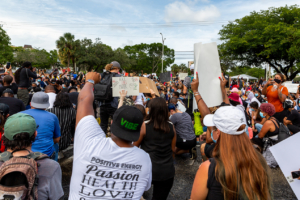 Recently the nation has experienced protests at a scale and duration not seen in decades. The act of protest has always carried risks: Under previous circumstances, demonstrators and community members have faced the possible dangers of violence, tear gas and arrest. Now, public protests carry the added threat of COVID-19 transmission.
Recently the nation has experienced protests at a scale and duration not seen in decades. The act of protest has always carried risks: Under previous circumstances, demonstrators and community members have faced the possible dangers of violence, tear gas and arrest. Now, public protests carry the added threat of COVID-19 transmission.
Keck Medicine of USC experts say there are steps that protestors can take to stay as safe and healthy as possible, both physically and mentally.
Acknowledge the trauma
According to many mental health professionals, members of the public have been experiencing significantly more stress than usual. The pandemic, and the economic losses and uncertainty that have come with it, have left many people without much room to tolerate further trauma.
Steven Siegel, MD, psychiatrist with Keck Medicine and chair of the Department of Psychiatry and Behavioral Sciences at the Keck School of Medicine of USC, pointed out that feeling unheard can add to a person’s existing trauma, hurting them even more deeply. He points out that It is crucial to not only listen receptively to those in pain, but to acknowledge and process one’s own trauma.
“During turmoil, as always, it is key that we acknowledge and address all forms of trauma, including the psychological trauma caused by racism,” Siegel said. “The recent events leading up to protests nationwide have made the call for mental health support all the more urgent across all communities.”
Minimize the risk of COVID-19 transmission
“While being outside may dilute the virus, especially if the wind is blowing, it’s still important to take basic precautions to reduce the risk of COVID-19,” said Neha Nanda, MD, medical director of infection prevention and antimicrobial stewardship for Keck Medicine.
While protesting, it’s important to take the following precautions even if one can’t stay six feet away from others:
- Sanitize your hands, either with soap and water or hand sanitizer, regularly and immediately after touching someone or something, or coughing or sneezing. Carry hand sanitizer with you at all times.
- Wear a mask or face covering while outside and around people at all times.
- Minimize bringing unnecessary items with you, as you will have fewer items to disinfect later.
- Wash all clothes and items you wore or brought immediately after returning home.
Nanda also stresses that participants should self-monitor for symptoms in the days after a demonstration. Signs of COVID-19 to look out for include cough, fever or chills, shortness of breath, muscle aches, headaches, new loss of taste or smell, sore throat, nausea, vomiting or diarrhea. It is crucial for people experiencing any of these symptoms to call a doctor immediately. Nanda also urged people with serious pre-existing conditions to stay home and find alternative ways to show their support.
Avoid tear gas whenever possible
While the name “tear gas” may give the impression of a harmless substance that makes one’s eyes water, the impact the gas has on the human body is much more serious.
According to Richard J. Castriotta, MD, a pulmonary critical care physician with Keck Medicine, tear gas sets off a pulmonary reaction that causes severe coughing.
“People should make sure they separate from others when coughing or around those coughing to avoid the spread of COVID-19,” he urged.
Respiratory issues are not the only danger: Kimberly Gokoffski, MD, PhD, an ophthalmologist with the USC Roski Eye Institute, stresses the very real danger that tear gas presents to the eyes.
“Tear gas burns the front of the eyes (the cornea), which is the window that allows us to see,” she explained. “If the cornea is burned and scarred, it can lead to blindness.”
Gokoffski urges those affected by tear gas to flush their eyes with water for at least 30 minutes, making sure to include the area between the eyelid and the cornea. When a sink is not available, use bottled water to flush out the eyes.
Stay prepared for medical emergencies
Protestors are constantly at risk for a range of injuries, whether it’s a simple trip-and-fall or being caught in a situation that turns violent. Armand Dorian, MD, MMM, chief medical officer of USC Verdugo Hills Hospital, encourages protestors to pack a first aid kit among their supplies.
He also stresses that those who need immediate medical help — for injuries such as deep cuts requiring stitches, severe asthma attacks or broken bones — should go to their nearest emergency room without delay. Dorian also assures members of the public that emergency departments are set up to prevent the transmission of COVID-19.
“Emergency departments are open and safe for all urgent and emergency needs,” he explained. “Hospitals are putting numerous safety practices in place to ensure patients are safeguarded from the possible spread of the coronavirus, so people should feel comfortable going there if needed.”
— by Kate Faye